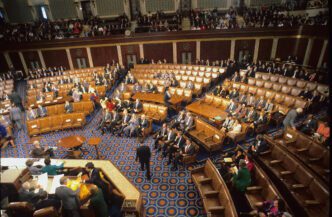Executive Summary
- The U.S. economy added a much lower-than-expected 22,000 jobs in August, with the unemployment rate rising to 4.3%, signaling a significant slowdown in the labor market.
- Further indicators of a cooling labor market include job openings falling to a 10-month low, with unemployed individuals now outnumbering available positions, and a notable rise in unemployment among Black workers to 7.5%.
- The report follows President Trump’s dismissal of the previous BLS commissioner after he baselessly claimed earlier job numbers were “rigged,” raising political controversy over the agency’s data integrity.
The Story So Far
- The U.S. labor market has been showing consistent signs of cooling, with economists attributing this slowdown to factors like President Trump’s aggressive trade agenda and an uncertain business environment, which have dampened job growth. This economic deceleration is compounded by a highly politicized environment surrounding government data, as President Trump recently dismissed the previous BLS commissioner over baseless claims of “rigged” job numbers, raising concerns about the integrity and interpretation of economic reports. Consequently, a weaker jobs report is now widely viewed by markets as providing justification for the Federal Reserve to implement interest rate cuts.
Why This Matters
- The significant slowdown in U.S. job growth, coupled with rising unemployment and a drop in job openings, signals a cooling labor market that could accelerate fears of a recession and increase pressure on the Federal Reserve to cut interest rates. This economic uncertainty is further complicated by President Trump’s public questioning of the integrity of government data, potentially eroding public trust in crucial economic indicators.
Who Thinks What?
- Economists and market analysts widely interpret the August jobs report as a clear indication of a significant slowdown in the labor market, citing fewer job openings, softer wage growth, rising unemployment, and potential justification for Federal Reserve interest rate cuts.
- President Donald Trump and Commerce Secretary Howard Lutnick have publicly questioned the integrity of previous Bureau of Labor Statistics data, claiming it was “rigged” and “bent against Donald Trump,” and suggested new leadership would produce “correct numbers,” though Trump also expressed skepticism about the current report.
The U.S. economy added significantly fewer jobs than expected in August, with just 22,000 positions reported by the Bureau of Labor Statistics (BLS) on Friday, signaling a notable slowdown in the labor market. This figure falls far short of economists’ forecasts of approximately 76,500 new jobs, with the unemployment rate simultaneously rising to 4.3% from 4.2%. The report marks the first data release under a new BLS leader, following President Donald Trump’s dismissal of the previous commissioner, Erika McEntarfer, after he baselessly claimed earlier disappointing job numbers were “rigged.”
August Job Report Highlights
The August job gains represent the lowest monthly total since December 2020, ending the second-longest period of employment expansion on record for the United States. Furthermore, the BLS report included substantial downward revisions for previous months. July’s job additions were revised down, and June’s initial gain of 14,000 positions was revised to a net loss of 13,000.
Economists widely interpreted the data as a clear indication that the once-booming labor market has stalled. Ger Doyle, regional president at ManpowerGroup, noted that the “broader labor market is cooling,” citing fewer job openings, softer wage growth, and longer job searches as signs of a slowdown. Jeff Schulze, head of economic and market strategy at ClearBridge Investments, stated the report “did little to quell fears of a recessionary-esque labor backdrop.”
Rising Unemployment and Specific Demographics
The national unemployment rate’s increase to 4.3% marks its highest level since October 2021. This rise is particularly pronounced among Black workers, whose unemployment rate climbed to 7.5% in August, also the highest since October 2021. This figure follows increases from 6% in June to 6.8% in July and then to 7.2% in July (as previously reported).
Dean Baker, senior economist at the Center for Economic and Policy Research, indicated that such a rise in Black unemployment, often seen as a “canary in the coal mine,” could foretell a broader deterioration in the labor market. The demographic data in the household survey, while volatile due to smaller sample sizes, suggests a serious shift.
Job Openings and Labor Demand
Further signaling a cooling market, the number of job openings fell to 7.18 million at the end of July, its lowest level in 10 months. For the first time since April 2021, the number of unemployed individuals, at 7.2 million, now exceeds the available job openings. Heather Long, chief economist at Navy Federal Credit Union, described this as a “turning point” for the labor market, calling it “yet another crack.”
Federal Reserve Chair Jerome Powell has emphasized the unemployment rate as the primary indicator to watch. He noted in late July that while the rate was “very low” at 4.1% for June, the decline in both worker demand and supply suggests a “breakeven number” for job additions has decreased, indicating “downside risk.”
Political Controversy Surrounding BLS Data
The August report follows a period of intense scrutiny and political controversy surrounding the Bureau of Labor Statistics. President Trump dismissed former BLS Commissioner Erika McEntarfer in July after a disappointing jobs report, baselessly claiming the data was “rigged” for political purposes. Commerce Secretary Howard Lutnick echoed these sentiments, suggesting that the previous BLS leadership was “bent against Donald Trump and America’s success,” leading to skewed numbers.
Lutnick stated that the new acting BLS commissioner would ensure the agency is “onside” and produces “correct numbers,” aiming to “take out the people trying to create noise.” However, experts and former BLS commissioners have consistently maintained that the agency’s data collection and reporting processes prevent individual manipulation.
President Trump himself declined to say whether he would believe Friday’s report, stating on Thursday that the “real numbers” would emerge in a year from now, tied to future investments in tech infrastructure.
Economic Context and Market Reactions
Economists have long warned of a cooling job market, pointing to consistently slowing job gains amid President Trump’s aggressive trade agenda. Forecasts suggest that higher prices for imported goods and an uncertain business environment could take a toll on the labor market. While the unemployment rate has remained relatively low, employers appear less eager to hire new workers.
Annual growth in average hourly earnings is also expected to slow to 3.7% from 3.9%, which could further dampen consumer spending as inflation begins to tick up. The labor market has become increasingly reliant on a dwindling number of industries for job growth, primarily healthcare and social assistance. Other sectors, such as professional and business services, retail trade, and manufacturing, are anticipated to see muted or negative employment trends.
On Wall Street, investors showed mixed reactions but largely hoped a weaker jobs report would provide more justification for the Federal Reserve to cut interest rates. Traders on Friday morning were pricing in a 99.7% chance of a rate cut in September. Eric Teal, chief investment officer at Comerica Wealth Management, noted that “the weaker the jobs data, the more cover there is for stimulative interest rate cuts that are on the horizon.”
The August jobs report underscores a significant shift in the U.S. labor market, moving from a period of robust expansion to one of marked deceleration. Amid rising unemployment, particularly for Black workers, and a political dispute over the integrity of government data, economists and policymakers are closely monitoring these trends for their implications on broader economic stability and future monetary policy decisions.








